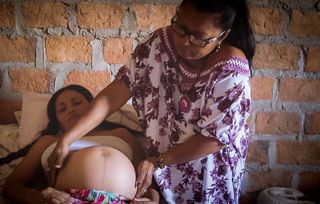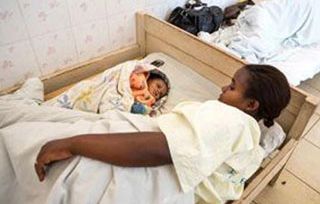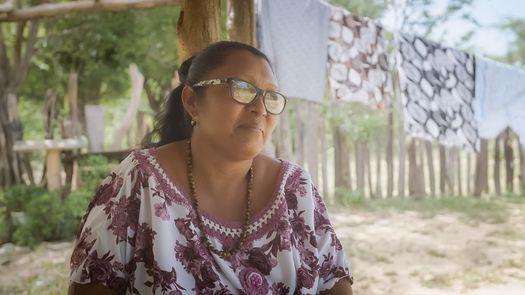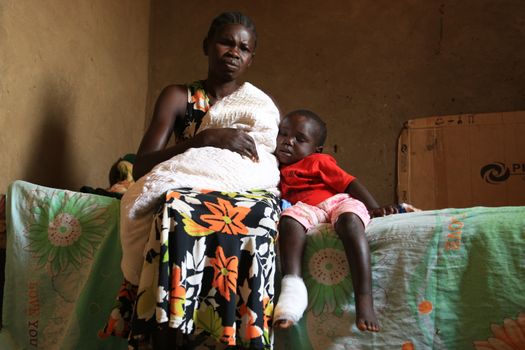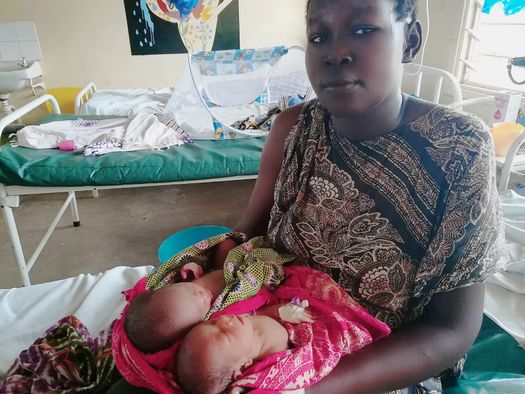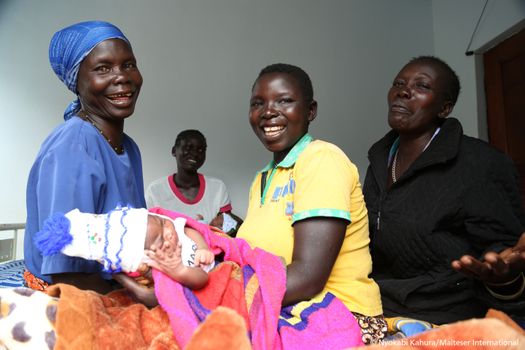
A global problem: Maternal and child mortality
Maternal mortality is globally declining and has fallen by more than a third since 2000 to 2020 - while an estimated 446,000 deaths were registered in 2000, the figure was only 287,000 in 2020. But still, a pregnant woman dies every two minutes worldwide.
The reasons for mortality are manifold. Most cases are due to inadequate medical care or obstetric care. Complications often occur as early as during pregnancy and the risk of death for mothers and their babies increases during the delivery due to a lack of professional help on site. A lack of education and poor nutrition also increase the risk of mortality.
This is why we are specifically involved in prenatal and postnatal care as well as obstetrics and offer various aid measures in our project countries with a focus on mother-child health, such as careful educational work for mothers. In this way, we contribute to further reducing mortality rates.

What does maternal mortality mean?
The WHO speaks of maternal mortality when the mother dies during pregnancy or within the first 42 days after giving birth, unless this is due to an accident or fortuitous circumstances.
A distinction is made between deaths that occur more than 42 days but less than one year after birth, known as "late maternal deaths". Various pregnancy or birth complications, especially in combination with life-sustaining procedures, can lead to delayed maternal deaths. The maternal mortality rate indicates how many mothers die per 100,000 live births within a certain period of time.
What does child mortality mean?
Neonatal mortality describes the annual number of infant deaths within the first month of life. However, it is not only shortly after birth, during delivery or during pregnancy that many children's lives are at risk. Data on infant mortality worldwide shows that thousands of children die every day before the age of five, often from preventable causes. As with maternal and child mortality, there are major differences between countries in the Global North and countries in the Global South, as well as between population groups within a country.
Maternal and child mortality - A global comparison
A global comparison of maternal and infant mortality rates shows clear disparities between countries in the Global South and countries in the Global North. For example, the absolute number of mothers who died during childbirth in Germany in 2020 was 34. In Tanzania, by contrast, 5,400 mothers died in the same year and the Democratic Republic of Congo recorded a shocking 22,000 mothers who died during or shortly after childbirth. This corresponds to a maternal mortality rate of 547 per 100,000 live births (as of 2020). There is also a global difference in child mortality. In Germany in 2021, for example, there were around 1,700 newborns who did not survive their first month of life. In comparison, the Democratic Republic of the Congo - according to its own calculations - recorded around 108,500 newborns who do not live beyond one month (as at 2021/2022).
| Germany | Tanzania | DR Congo | Agenda 2030 Target | |
| Mothers who died during childbirth (incl. maternal mortality rate) As of: 2020, Source: UNICEF | 34 (4 per 100,000 live births) | 5,400 (238 per 100,000 live births) | 22,000 (547 per 100,000 live births) | max. 70 per 100,000 live births |
| Newborns who do not survive the first month of life (incl. child mortality rate) As of: 2021/2022, Source: Destatis (2021, Germany figure), own calculations + UNICEF / IGME | 1,735 (2.19 per 1,000 live births) | 44,936 (20.01 per 1,000 live births) | 108,533 (26.48 per 1,000 live births) | max. 12 per 1,000 live births |
| Newborns who do not survive the first year (incl. child mortality rate) As of: 2021/2022, Source: Destatis (2021, Germany figure) own calculations + UNICEF / IGME | 2,368 (3.03 per 1,000 live births) | 76,600 (34.11 per 1,000 live births) | 255,636 (62.37 per 1,000 live births) | - |
Maternal mortality during pregnancy
Complications during pregnancy are not uncommon, but in many countries of the Global South, these become a serious risk for mother and child and often contribute to an increased maternal mortality rate. Multiple pregnancies in particular require close medical care, which often cannot be guaranteed locally. If the expectant mother is under 18 or over 35 years old, the pregnancy is also generally a high-risk pregnancy. If bleeding occurs during pregnancy, this can also lead to complications and increase the risk for the unborn child and the mother.

Other possible risks during pregnancy for the mother and the baby:
- Chronic malnutrition of the mother
- There is an ectopic pregnancy
- Poor hygiene conditions lead to sepsis or infection
- High blood pressure develops into pre-eclampsia (also known as pregnancy poisoning), which can cause a miscarriage
- The mother suffers from a heart, circulatory or kidney disease
In Germany and many other countries in the Global North, the diagnosis of a high-risk pregnancy may lead to additional examinations and further medical measures being initiated in order to provide the mother and her baby with the best possible care and prevent further complications such as bleeding. Some of these additional measures are also covered by health insurance companies.
In other parts of the world, such intensive care and monitoring of pregnant women is often not possible. Long distances to medical facilities, a lack of financial resources, inadequately trained health personnel, insufficient education and little information for girls and women make conditions more difficult. This can have fatal consequences, especially in poorer countries.
Mother and child deaths: The risk to die during birth
The delivery itself is a major challenge for mother and child, especially if there is an inadequate medical infrastructure. In many countries, there is not only a lack of suitable facilities for a safe birth, but also a lack of the right medical equipment. In addition, there is often a lack of medication and professional birth attendants to care for mothers before, during and after the birth. In many countries, the nearest hospital is far away or difficult to reach. For pregnant women in rural areas, this makes access to medical care during childbirth almost impossible, meaning that infections, unstoppable bleeding or other illnesses threaten the lives of newborns and mothers. The maternal and infant mortality rates in these regions are correspondingly high.
The greatest risk for mothers and their babies is during and immediately after childbirth. According to estimates, prolonged labor, heavy bleeding or incorrect positioning of the child lead to the death of 2.8 million mothers and newborns per year during this high-risk phase. For children who survive birth, however, the first month of life often also carries a high risk of death. This is particularly true for babies who were born prematurely or who had complications during birth. Nevertheless, the day of birth carries a particular risk for the child: around a third of all deaths of newborns who do not survive their first month of life occur on the day of delivery.
What are the consequences if the mother or baby dies at birth?
The risks associated with childbirth in countries of the Global South mean that, in the worst case scenario, mother and child die during or after delivery. But often only the mother or only the newborn survives. However, these cases have far-reaching consequences for the survivors:
If only the newborn survives without its mother:
- The mother dies after giving birth and is therefore unable to care for the child. This rapidly increases the risk of the newborn dying.
- The lack of breast milk makes natural immunization much more difficult, making the child more susceptible to illness.
- Growing up without a mother is a heavy emotional burden for the child and has an enormous impact on the child's personal development.
- The burden on the rest of the family is just as great, as they lose an important family member, grieve and have to care for a newborn at the same time. Depending on the family's financial situation, they may also have to deal with debts incurred due to the hospital costs for mother and child, the funeral costs and feeding the new child - while at the same time the mother is no longer able to work.
If only the mother survives without her child:
- If the child dies during or shortly after birth, this is an immense emotional burden for mothers.
- This stroke of fate can sometimes lead to severe depression, and feelings of guilt and failure are not uncommon.
- Some mothers suffer lifelong psychological and emotional consequences as a result of complications during childbirth.
We care about the well-being of pregnant women and newborns
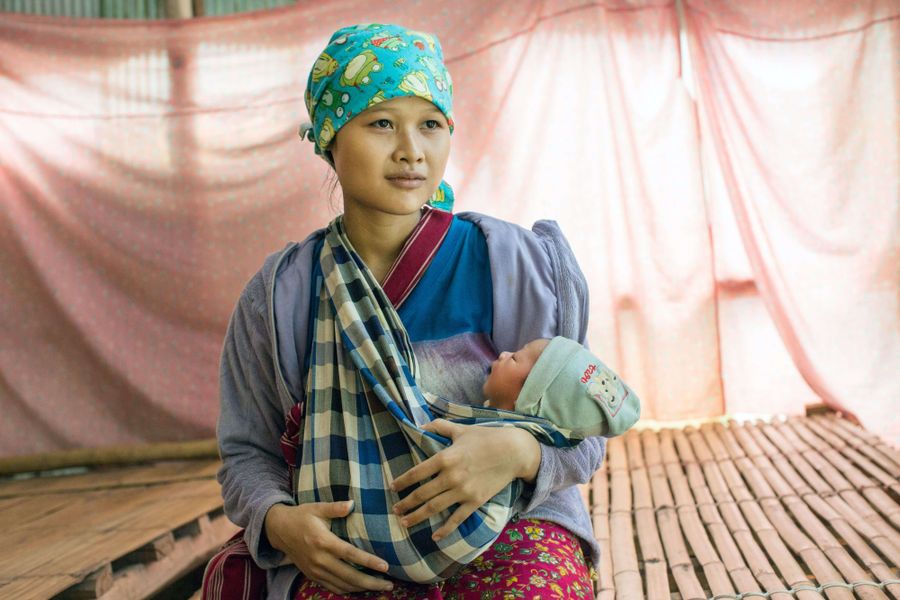
In the Agenda 2030 ("Sustainable Development Goals", SDGs), the United Nations define 17 different goals for sustainable development. The third goal, SDG 3 "Good health and well-being", specifically addresses the global problem of maternal and infant mortality. We are doing our part to help reduce maternal and infant mortality by implementing various health and aid measures in our project countries. Our aim is to strengthen prenatal and postnatal care locally and to give expectant mothers better access to high-quality obstetric care.
For example, we build maternity clinics and equip existing health centers with the necessary medical equipment and medicines. The maternity clinics have delivery rooms and professionally equipped operating theaters so that, for example, a caesarean section can be performed in the event of pregnancy complications. We also train midwives and specialist medical staff so that mothers and their children receive comprehensive care before, during and after the birth.
By ensuring an adequate water supply on site, hygiene standards can be maintained in the facilities. In this way, we reduce the risk of transmission of infectious diseases such as malaria, blood poisoning or diarrhea, which can occur during and after childbirth.
Our awareness-raising efforts inform the population in the surrounding regions about our health facilities and draws the attention of women and expectant mothers in particular to the need for obstetric assistance and care by trained staff.
Our projects for better mother-child health
As part of our refugee aid in Thailand, for instance, we are specifically committed to pre- and postnatal care for pregnant women and ensure that they are referred to a Thai hospital for delivery in the event of a high-risk pregnancy. To improve health conditions in refugee camps in Bangladesh, we also provide important health services for mothers and children in three health centers in various camps.
We also attach particular importance to monitoring the nutritional status of pregnant women, breastfeeding mothers and babies on site. Medical emergencies are referred to the nearest hospital. Health workers support pregnant women in the refugee camps in Bangladesh and raise their awareness of the need for medical check-ups.
Frequently Asked Questions
Africa has the highest maternal mortality rate in the world. Sub-Saharan Africa alone accounted for around 70 percent of total global maternal mortality in 2020. It is highest in South Sudan with 1,223 deaths per 100,000 births (as of 2020). However, the risk for expectant mothers is also very high in other regions of Africa. In Chad, it is 1,063 and in Nigeria 1,047 deaths per 100,000 births (as of 2020).
The likelihood of women dying in childbirth varies greatly around the world. In addition to unequal access to medical care, this also depends on how many children a single woman has. On average, women in countries of the Global South are pregnant more often in their lifetime than women in the Global North and are therefore exposed to a higher risk of dying in connection with pregnancy or as a result of childbirth. This so-called lifetime risk describes the probability of a 15-year-old woman dying from the consequences of childbirth in the medium to long term. In high-income countries, this affects 1 in 5400 women, in poorer countries 1 in 45 women.
The coronavirus pandemic has put considerable strain on healthcare systems worldwide. Restrictions on healthcare services and a shortage of medical staff and materials meant that routine and preventive check-ups were often unable to take place. According to a study, services for mothers and children in 18 countries surveyed (including Afghanistan, Ghana, Nigeria and Uganda) fell by an average of 2.6% to 4.6%, and avoidable examinations and operations had to be postponed so that only patients with COVID-19 could be treated. In particular, hospitals in countries with an already weak infrastructure were sometimes severely overloaded due to the pandemic and its restrictions and were often unable to provide pregnant women with adequate care.


